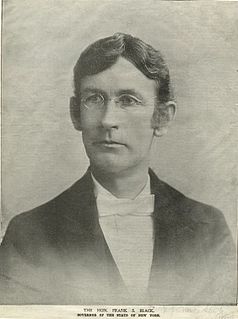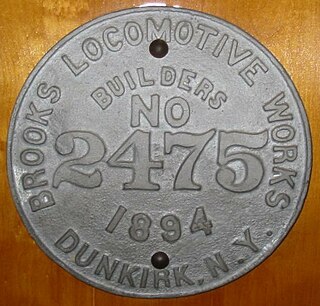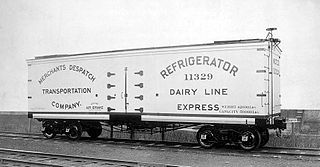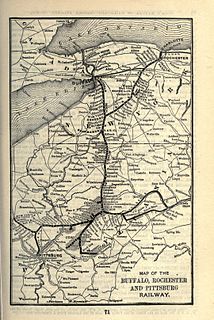
Averill Park is a census-designated place within the town of Sand Lake in Rensselaer County, New York, United States. The population was 1,693 at the 2010 census.

Dunkirk is a city in Chautauqua County, New York, in the United States. It was settled around 1805 and incorporated in 1880. The population was 12,743 as of the 2020 census, with an estimated population of 11,756 in 2019. Dunkirk is bordered on the north by Lake Erie. It shares a border with the village of Fredonia to the south, and with the town of Dunkirk to the east and west. Dunkirk is the westernmost city in the state of New York.

The New York Central Railroad was a railroad primarily operating in the Great Lakes and Mid-Atlantic regions of the United States. The railroad primarily connected greater New York and Boston in the east with Chicago and St. Louis in the Midwest, along with the intermediate cities of Albany, Buffalo, Cleveland, Cincinnati, Detroit, and Syracuse. New York Central was headquartered in New York City's New York Central Building, adjacent to its largest station, Grand Central Terminal.
The Erie Railroad was a railroad that operated in the northeastern United States, originally connecting New York City — more specifically Jersey City, New Jersey, where Erie's Pavonia Terminal, long demolished, used to stand — with Lake Erie, at Dunkirk, New York. It expanded west to Chicago with its 1865 merger with the former Atlantic and Great Western Railroad, also known as the New York, Pennsylvania and Ohio Railroad. Its mainline route proved influential in the development and economic growth of the Southern Tier of New York State, including cities such as Binghamton, Elmira, and Hornell. The Erie Railroad repair shops were located in Hornell and was Hornell's largest employer. Hornell was also where Erie's mainline split into two routes, one north to Buffalo and the other west to Chicago.

Frank Swett Black was an American newspaper editor, lawyer and politician. A Republican, he was a member of the United States House of Representatives from 1895 to 1897, and the 32nd Governor of New York from 1897 to 1898.

The Brooks Locomotive Works manufactured railroad steam locomotives and freight cars from 1869 through its merger into the American Locomotive Company (ALCO) in 1901.

The Rochester Industrial and Rapid Transit Railway, more commonly known as the Rochester subway was a light rail rapid transit line in the city of Rochester, New York, from 1927 to 1956. The subway was constructed in the bed of the old Erie Canal, which allowed the route to be grade-separated for its entire length. Two miles (3.2 km) of the route through downtown were constructed in a cut-and-cover tunnel that became Broad Street, and the only underground portion of the subway. The Rochester Subway was designed to reduce interurban traffic on city streets, and to facilitate freight interchange between the railroads. The line was operated on a contract basis by New York State Railways until Rochester Transit Corporation (RTC) took over in 1938. The last day of passenger service was June 30, 1956. Portions of the right-of-way were used for expressway construction, while the rest was abandoned and filled in over the years. The largest remaining section is a stretch of tunnel under Broad Street from Exchange Street to the intersection of Court Street and South Avenue.

The Merchants Despatch Transportation Company was established in 1857 or 1858 by the American Express Company of New York. The entity was reformed as a joint stock trading company on June 1, 1869, with ownership divided among the Cleveland, Columbus, Cincinnati and Indianapolis Railway (CCC&I), the Lake Shore and Michigan Southern Railway, and the New York Central Railroad (NYC), all part of the Cornelius Vanderbilt rail empire.

Edward Murphy Jr. was a businessman and politician from Troy, New York. A Democrat, he served as mayor of Troy, New York (1875–1883), chairman of the New York State Democratic Committee (1888–1894), and a United States Senator from New York (1893–1899).
The Owasco River Railway was a switching railroad that provided rail service to several industries on the Owasco River in Auburn, New York, interchanging with the New York Central Railroad and the Lehigh Valley Railroad via trackage rights on the New York Central. Incorporated on June 2, 1881, completed construction in 1882, and opened by 1886, it was initially owned by the International Harvester Company. In 1919, the Interstate Commerce Commission found, in a decision for the Owasco River Railroad, that short line and industrial railroads were common carriers and were entitled to appropriate haulage rates from trunk lines.

The International Railway Company (IRC) was a transportation company formed in a 1902 merger between several Buffalo-area interurban and street railways. The city railways that merged were the West Side Street Railway, the Crosstown Street Railway and the Buffalo Traction Company. The suburban railroads that merged included the Buffalo & Niagara Electric Street Railway, and its subsidiary the Buffalo, Lockport & Olcott Beach Railway; the Buffalo, Depew & Lancaster Railway; and the Niagara Falls Park & River Railway. Later the IRC acquired the Niagara Gorge Railroad (NGRR) as a subsidiary, which was sold in 1924 to the Niagara Falls Power Company. The NGRR also leased the Lewiston & Youngstown Frontier Railroad.
Buffalo Car Manufacturing Company, also known as Buffalo Car Company or Buffalo Car Works, was an American manufacturer of railroad freight cars in the late 19th century. In 1899, this company was merged with twelve others to form American Car and Foundry Company.

Frederick Cook was an American businessman and politician. He served as the New York Secretary of State from 1886 to 1889.

The Buffalo, Rochester and Pittsburgh Railway was one of the more than ten thousand railroad companies founded in North America. It lasted much longer than most, serving communities from the shore of Lake Ontario to the center of western Pennsylvania.
Chartered in 1904 by the Beebe Syndicate, the Auburn and Northern Electric Railroad connected the city of Auburn, New York, with the Rochester, Syracuse and Eastern Railroad at Port Byron, New York. The New York Board of Railroad Commissioners authorized construction and a $1 million mortgage to the A&N in 1905 so it could build 12 miles (19 km) of track between Auburn and Port Byron. Lease of the line to be used by A&N was negotiated at an Auburn and Syracuse Electric Railroad stockholders' meeting in May 1907. Construction of the line was contested by the Lehigh Valley Railroad who initiated a frog war when the A&N tried to build a crossing at its tracks; the A&N obtained an injunction and continued building. The railroad began operation in 1908. Lehigh Valley Railroad kept the crossing as a point of contention with an order from the railroad commission in 1909 requiring the A&N to install and operate derails at the crossing.
The Hornell Traction Company was an electric streetcar company serving Hornell and Canisteo, New York, between 1892 and 1926.

Avon is a former railroad station for the Erie Railroad in the village of Avon, Livingston County, New York. One of the more active hubs of the Erie Railroad, Avon served as the terminus of four different Erie lines: the Rochester Division, the Rochester Branch (Rochester–Avon), the Mount Morris Branch, and the Attica Branch.
The Lackawanna Limited wreck occurred when a Delaware, Lackawanna and Western Railroad (DL&W) passenger train, the New York-Buffalo Lackawanna Limited with 500 passengers, crashed into a freight train on August 30, 1943, killing 29 people in the small Steuben County community of Wayland in upstate New York, approximately 40 miles (64 km) south of Rochester.

Uri Gilbert was an American carriage maker from Troy, New York, making both passenger and freight cars. He was apprenticed at the age of 14 to learn the carriage-building trade. At the end of his apprenticeship he became partner with Oramus Eaton of the Eaton & Gilbert Company. He kept pace with technological advancements and expanded the business by the time Eaton retired and Gilbert established the Gilbert Car Company. The companies produced passenger trolley and railroad cars, freight cars, and during the American Civil War, gun carriages. He entered politics in the 1840s becoming alderman and the mayor of Troy. Gilbert was active in many for-profit and civic organizations over the course of his life. He employed Charles Nalle as a coachman and when he was arrested due to the Fugitive Slave Law, he helped free him.













